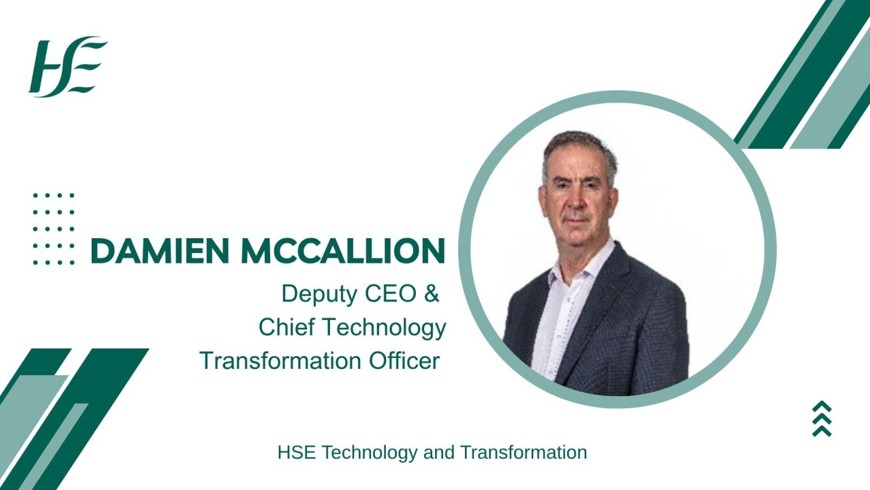
One Year On: Reflections and Priorities from Damien McCallion, Chief Technology & Transformation Officer
This summer marks one year since I stepped into the role of Chief Technology and Transformation Officer (CTTO) for the Health Service Executive. It’s been a year of enormous momentum, strong collaboration, and real delivery across the health service. While the technology matters, what’s most striking and most energising is the people driving the work forward.
The People Behind the Progress
Across every team I’ve engaged with, from frontline staff to technology specialists, the commitment to digital transformation is undeniable. Whether it's in a hospital ward, community clinic, programme team or department office, there’s a genuine sense of ownership. That’s what makes the difference. Digital transformation isn’t just a tech project it’s a whole-service evolution, and people are at the heart of it.
Key Achievements Over the Past Year
In just 12 months, we’ve made progress on multiple fronts.
- The HSE Health App was launched, offering patients a trusted, secure place to view information, starting with maternity and gynaecology appointments. We’ll continue to build on this with three planned releases each year.
- EHR progress continues, with maternity services leading the way. The results are clear: improved safety, better access to information, and time released back to clinicians. It’s a strong foundation for the national rollout now under development.
- Community Connect is being fast-tracked to bring digital capability to community services that have historically been under-supported. This foundational system will ensure community teams are better equipped, while also preparing them for full EHR integration in the future.
- MedLIS went live at Beaumont Hospital our first major deployment of the national laboratory system. It’s already improving service delivery and will continue to roll out across the country.
- Cybersecurity, Wi-Fi enablement, and infrastructure modernisation have all advanced steadily quietly critical work that enables the entire health system to function securely and efficiently.
We’ve also made big strides in partnerships with GS1 on coding standards, HealthTech Ireland on industry collaboration, and through formal patient panels and community engagement forums. And we’ve welcomed the HSE’s first Chief Data & Analytics Officer, a vital step as we develop our national AI strategy.
Digital for Care 2030: A National Direction
Digital for Care 2030 continues to act as our strategic North Star. It’s about delivering safer, more integrated, and people-centred healthcare across Ireland. But it’s not a standalone plan it’s embedded within Sláintecare and aligned with broader reform efforts across health and social care.
For patients and the public, the benefits are becoming more visible: a secure app for appointments, smoother interactions with services, and better access to information. For staff, it’s about having the tools, systems and support to do their jobs more efficiently and safely.
The principle is simple: digital enables better care but only when aligned with strong service pathways, leadership, and governance.
Supporting Our Staff Through Change
A transformation of this scale depends on how well we support our people. We’ve expanded training, digital literacy initiatives, and leadership development especially for clinical and administrative staff working on digital projects. Whether you're a nurse, pharmacist, administrator or architect, everyone has a role in shaping digital care.
What’s also clear is that success hinges on teamwork. Our digital teams are no longer just IT they’re multidisciplinary, including project managers, clinicians, procurement, HR, and service leads. This shift is already evident in our regional structures and in the teams forming around our EHR programme.
The EHR Programme: A National Priority
There’s no doubt: the Electronic Health Record (EHR) programme is our most important digital investment. It will become the foundation for integrated, safe and efficient care nationwide. We’ve made strong progress advancing the business case, building the team, and preparing for implementation in Dublin Northeast as the first region.
The benefits already seen in our maternity EHR rollout safer prescribing, better documentation, more informed decisions are just the beginning. We’re learning from international leaders and moving through the necessary assurance and procurement phases with pace and precision.
Innovation and Momentum
Innovation doesn’t just happen in labs it happens on the ground. Whether it’s an AI-supported stroke pathway, predictive tools to identify at-risk patients, or a new way of structuring community care, ideas are emerging across the health system.
To support this, we’ve established an AI & Automation Centre of Excellence, developed a national AI Strategy, and are finalising an Innovation Framework for the entire health service making sure good ideas don’t just start, but scale.
Looking Ahead: Organising for Success
Over the next 12 months, you’ll see real delivery across Digital for Care. Several programmes will enter live service; others, like EHR, will move through key decision points. We’re also evolving our operating model to align with the new health regions and integrated care structures ensuring we’re positioned to deliver at scale, with agility.
My own focus will be on three key areas:
- Driving forward our strategic priorities and delivering benefits on the ground.
- Organising ourselves for success, across regions and national programmes.
- Strengthening collaboration with patients, government, clinicians, industry, and every team within the HSE.
In Summary
We’re not digitising for the sake of it. We’re doing this to make healthcare better safer, smarter, and more responsive for everyone. The scale of ambition is huge, but so is the momentum.
What excites me most is the growing appetite for change teams asking “Why not us? Why not now?” From my perspective, that ground-level energy is our greatest asset.
And now, our job is to harness it.
